Years after Corpus Christi ISD ends dual language program, other districts take it on
When educating bilingual students, the largest school district in the Coastal Bend, Corpus Christi ISD, currently relies on a transitional model that aims to move students into mainstream English classrooms within a few years of starting school.
But another bilingual education model is growing in popularity locally, with proponents arguing the “dual language” model leads to better outcomes for students. Until a couple of years ago, Corpus Christi ISD had its own dual language program. Since then, other area districts, including Tuloso-Midway ISD and Gregory-Portland ISD, have launched their own.
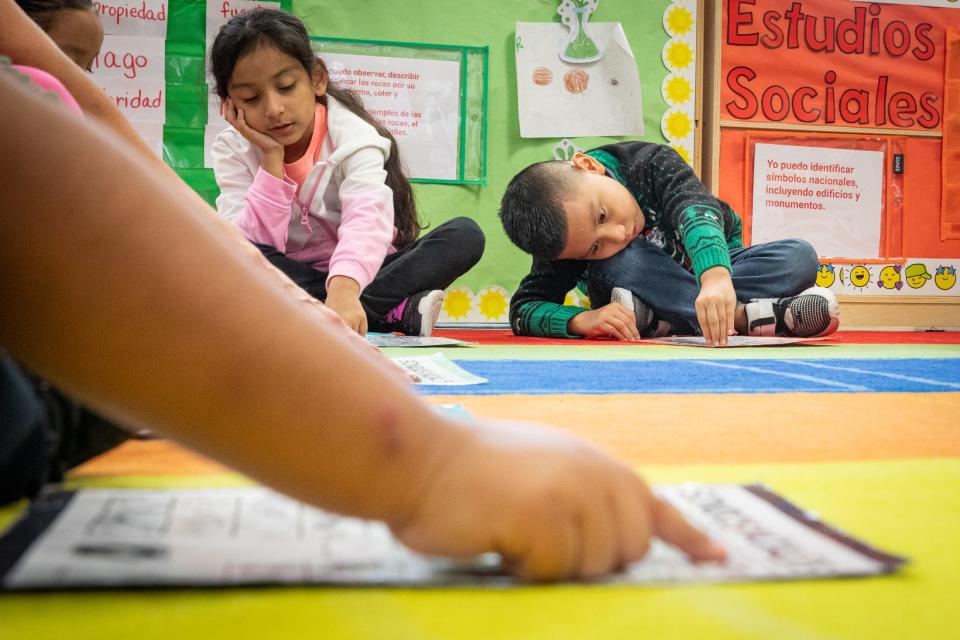
Over the past 10 years, the number of bilingual students in Texas has increased substantially. Across the state, 23% of students are considered emergent bilingual, which means they do not speak English as their primary language and have a limited ability to read, speak or understand English when they start school.
The state has historically struggled to close the achievement gap between bilingual students and non-bilingual students.
The graduation rate for bilingual students is lower than the rate for other students, including economically disadvantaged students. Emergent bilingual students also score below their peers in state assessments and are less likely to be considered college-ready.
Comparing bilingual education models
Texas has approved six bilingual program models – English as a Second Language pull-out, ESL content-based, transitional early-exit, transitional late-exit, dual language immersion one-way and dual language immersion two-way.
English as a Second Language: In ESL programs, students are taught by ESL-certified teachers who might not be fluent in the student’s native language. In ESL pull-out programs, students are placed in general education classrooms, but sometimes receive group or one-on-one English instruction from an ESL-certified teacher. An ESL program is often the best option for students if their school district does not have a teacher fluent in their native language, for example if there are less than 20 students in the same grade level who speak the same language.
Transitional: Students are served in both English and another language and have a bilingual-certified teacher. Early exit programs aim to transition students to English-only instruction after two to five years. In a late exit model, that transition happens between six and seven years after the student enrolls in school.
Dual language: The one-way model serves emergency bilingual students with the goal of success in English-only instruction after six or seven years of school. In the two-way model, emergent bilingual students are integrated in the classroom with students who are proficient in English where instruction is given in English and another language, promoting biliteracy for both sets of students.
The goal of the ESL and transitional bilingual program models is English proficiency.
The dual language, or DLI, program models have the added goals of promoting bilingualism and biliteracy.
Years of research have shown that students in dual language programs outperform students in transitional and ESL programs.
A 2004 study of large and small districts in 15 states showed that dual language programs are successful in closing the academic achievement gap between bilingual students and English proficient students.
“Overwhelming evidence shows that DLI programs are the only instructional programs that close the academic achievement gap between emergent bilingual students and non-emergent bilingual students,” according to a 2023 update to the Texas Effective Dual Language Immersion Framework.
The framework cites research showing increased academic achievement, cognitive development, self-regulation, emotional control, flexibility in thinking, planning skills, engagement in higher-level learning, linguistic proficiency, graduation rates, sense of identity and self-esteem and parent engagement and satisfaction.
In the Coastal Bend region, most bilingual students are served by transitional early-exit programs. Years ago, Corpus Christi ISD offered a dual language program. It doesn’t anymore.
Across the region, only a small handful of students — less than 30 in Gregory-Portland — were served in a dual language classroom last year, according to the Texas Education Agency’s 2022-2023 Emergent Bilingual/English Learner Program Report.
But that is now changing.
Gregory-Portland ISD first began offering dual language in 2022-23. Tuloso-Midway ISD launched a program this fall.
Tuloso-Midway ISD focuses on closing achievement gaps for bilingual students
In line with state and national trends, bilingual students in Tuloso-Midway ISD have historically underperformed compared to other students.
“We were unintentionally creating learning gaps for kids — asking them not to speak their native language, teaching them in a language they were unfamiliar with, meant they were getting these huge academic gaps — while they could cognitively do whatever we were asking, linguistically, they didn’t understand,” T-MISD assistant director of curriculum and instruction Kenna Moody said.
By the time their language ability caught up, students were already behind in academics.
To address this, Tuloso-Midway ISD turned to the dual language model. T-MISD Superintendent Steve VanMatre championed dual language in the district, instructing the leaders of Tuloso-Midway Primary School to implement a dual language program.
Though there is a shortage of bilingual educators in the state, the school already had a well-staffed bilingual staff and was able to add two new bilingual-certified teachers.
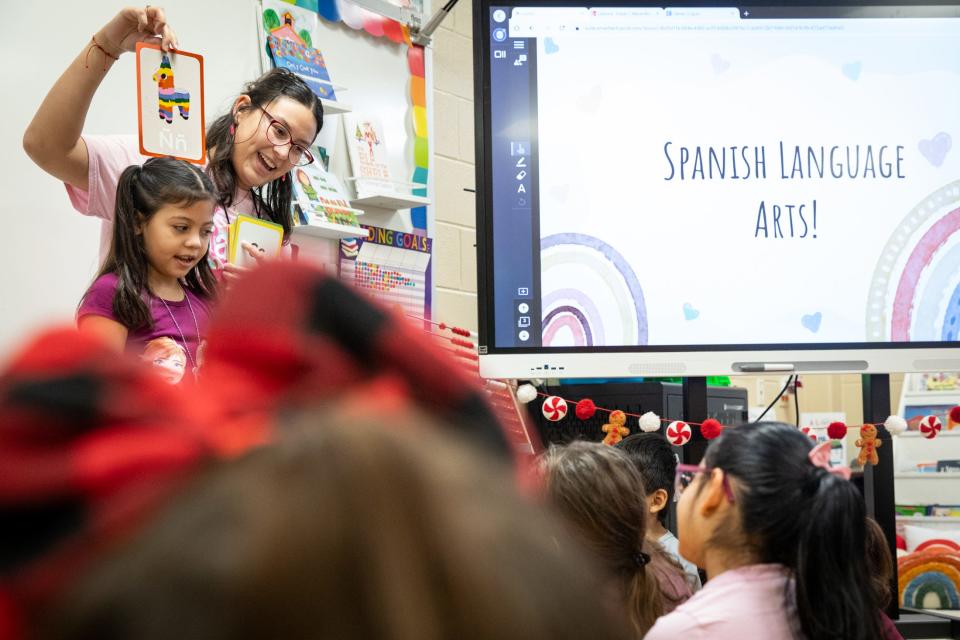
Additionally, two of the school’s leaders, Principal Laura Davila and assistant principal Nidia De La Cerda both have experience as bilingual educators. Some educators on staff, including De La Cerda, had prior experience as dual language teachers.
To start the program, Tuloso-Midway ISD turned to Gómez and Gómez, a consulting firm specializing in dual language. The firm’s founders, brothers Leo and Richard Gómez, were both professors of bilingual education at universities in Texas and have been helping school districts implement dual language programs for three decades.
This year, the school added a dual language program in pre-K, kindergarten and first grade at Tuloso-Midway Primary School. Eventually, as these students progress through school, the district plans to offer dual language through fifth grade.
There are two dual language classrooms in kindergarten and first grade and one classroom at the pre-K level because not all students start school in pre-K.
Dual language is the only bilingual program offered in pre-K, kindergarten and first grade, serving all bilingual students. Until dual language is rolled out for all elementary grade levels, the district will continue to offer transitional bilingual programs.
Through a two-way immersion model, students whose primary language is Spanish and students whose primary language is English are placed together in classrooms with bilingual teachers.
Students learn to read in their native language. Math lessons are in English and science and social studies are taught in Spanish.
“We genuinely believe that if we teach them the academic skills in their native language, the language part of things will happen by exposure,” Moody said. “They’ll be able to take their reading and phonics knowledge and transition that into either language as they get older.”
Teaching academics early in a student’s native language also helps educators identify potential learning disabilities or struggles, Moody said. Otherwise, it can be hard to tell if a child is struggling because they don’t have the language skills or because they need special education services. It’s also easier to identify gifted and talented students earlier, Moody said.
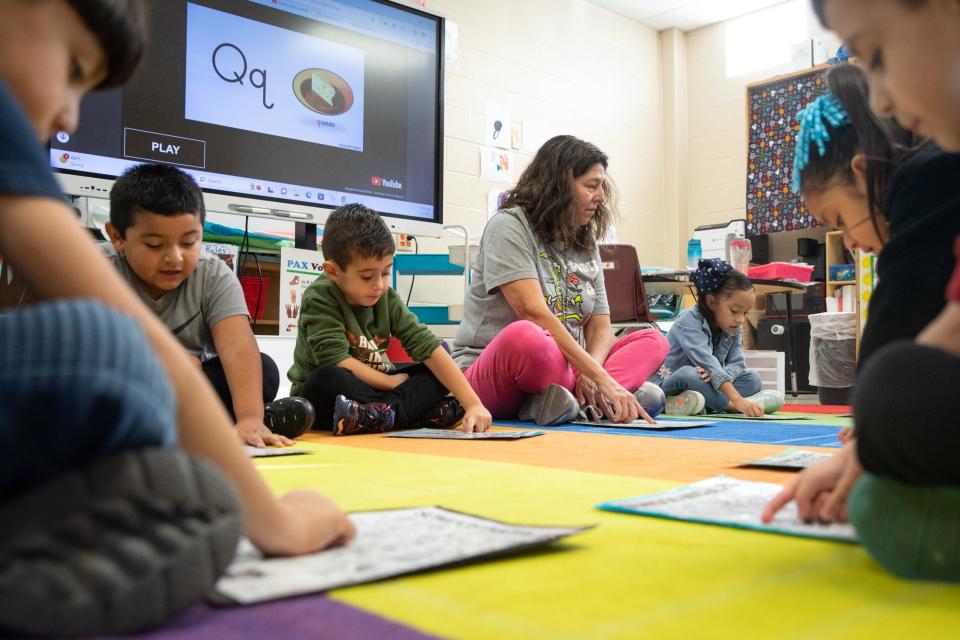
The goal in dual language is for students to learn from each other, supporting and helping one another understand both languages.
“We’ve already seen the academic skills in our students — both our native Spanish speakers and our English students — how they have progressed,” Davila said.
For English-proficient students, there’s a waiting list to get into the program.
Many of the English-proficient students in the program come from bilingual households and have family members who speak Spanish. Some have parents whose own parents spoke Spanish, but after growing up speaking English in the classroom, weren’t able to maintain their own bilingual abilities.
This is partially due to historical practices that discouraged the use of Spanish in schools in Texas, the impacts of which are still being felt today.
“My mom got in trouble for speaking Spanish in school, so when we were growing up, she did not want us to speak Spanish,” assistant principal Lepe Chapa said. “She didn’t want us to have an accent because she had a bad experience with it. Now, everybody wants to be bilingual... that these kids are going to be able to grow up speaking Spanish and writing and reading in Spanish and English, that’s amazing.”
De La Cerda’s first language growing up was Spanish. She was placed in a transitional bilingual classroom in pre-K, transitioning to an English classroom by kindergarten.
“To see these kids not have to go through that, as a native Spanish speaker, it’s something that I appreciate because these kids don’t have to lose their language,” De La Cerda said. “We’re going to help them keep it.”
Other students come from entirely English-speaking backgrounds, but their parents hope that speaking Spanish will benefit them in life.
“Our parents have been extremely supportive of the program,” Davila said.
For Spanish-dominant students, having Spanish coursework allows parents to become more involved with their child’s learning.
“The parents are very happy with the fact that they can support them,” De La Cerda said. “I’ve talked to some parents who (had students in a transitional program) last year and are in dual language this year and they just love knowing that the kids come home, and they can help them with their reading and they can help them with science and social studies.”
Regardless of background, students in the program are engaged and excited in the classroom, school staff said.
“Whenever we’re in the hallways or if we’re just passing by and we walk into the classroom, the students are ready to show us their Spanish,” Davila said.
The program has instilled a sense of pride in bilingual students, staff said.
“Before, it was like, ‘I have to learn everybody else’s language’,” De La Cerda said. “But now, there’s a value placed on that language and everybody notices that value.”
To further integrate the program into the wider campus community, the school plays morning announcements and the pledge of allegiance in English and Spanish for all students and includes signs and labels in both languages in the hallways.
“It’s not just in isolation,” Davila said. “We are promoting biliteracy across the campus and that’s only going to get better as we go on.”
Because the two-way model relies on a consistent ratio of Spanish and English students, growth of the program is limited by the district’s bilingual student enrollment.
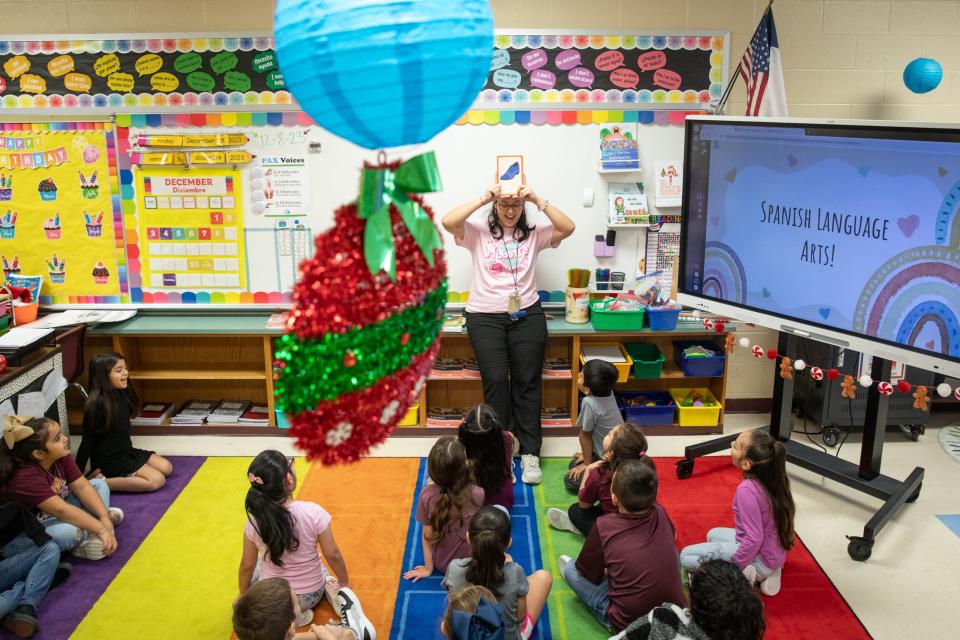
Kindergartener Isabella Campos comes from a bilingual household. Her father Paco grew up in a Spanish-speaking household, while her mother Kandice has an English-speaking background, though her parents are bilingual.
Both Paco and Kandice Campos believe that being bilingual is an advantage in the workplace. Paco added that it's also important to him that his children learn Spanish so that they can remain connected with older family members.
"Spanish was spoken in my home, but I didn't learn to speak it well and it was lost," Kandice Campos said. "We didn't want that to happen to her."
How Texas approaches bilingual education
Until about 50 years ago, Texas schools taught only in English.
A 1972 report from the U.S. Commission on Civil Rights, based on a hearing held in San Antonio in 1968 and a 1969 survey of Mexican American education in the Southwest found that many schools in Texas in particular discouraged the use of Spanish on schoolgrounds.
Norma Guzman is a professor of bilingual education and doctoral program coordinator at Texas A&M University-Kingsville. Before moving to higher education, Guzman was a school psychologist trained in bilingual assessments.
“Historically bilingual ed was established as part of the civil rights era,” Guzman said. “The initial programs were part of that social justice movement to ensure that English language learners were getting an equitable education.”
During the 1960s and '70s, South Texas civil rights advocates called attention to discriminatory practices against Mexican American students.
In the 1960s, some schools began experimenting with bilingual education models. In 1968, the Bilingual Education Act created a federal policy for bilingual education.
Corpus Christi ISD was the subject of a 1970 court case noting that the district had knowingly implemented discriminatory practices and segregated against Mexican American students.
In 1972, students in Robstown boycotted school for a month in response to a lack of bilingual and bicultural programming, calling for an end to discriminatory policies against Mexican American students and for the introduction of Chicano history courses.
Former senator Carlos Truan, who represented Nueces and Kleberg counties in the Texas Legislature, successfully sponsored the Texas Bilingual Education Act in 1973. Truan was a state representative at the time.
The act directed school districts with 20 or more students in the same grade sharing the same language to institute a bilingual instruction program beginning in 1974-75. It also helped fund bilingual education programs.
In the early 1970s, Texas A&M University-Kingsville launched a bilingual teacher preparation program for undergraduates and a bilingual education doctoral program.
Many early bilingual programs focused on helping student learn English so that they could be successful in mainstream classrooms. But, at the same time, another type of program gained steam – dual language.
Dual language programs often include English-proficient and English-learner students, with the goal of creating bilingual, bicultural and biliterate students.
“We’ve had dual language as a form of education since the ‘60s and probably before that,” Guzman said, referencing a program formed in Florida in 1963 to serve Cuban refugees.
The first dual language immersion bill in Texas passed in 2001, focusing on biliteracy goals. In 2019, the Texas Legislature approved a new dual language program allotment to incentivize school districts to offer dual language programs, particularly for emergent bilingual students.
In the 21st century, part of the appeal of dual language programs are the academic benefits to English-speaking students.
“It has become a program of choice for districts,” Guzman said.
But emergent bilingual students can also benefit greatly from a dual language program.
“To have that foundational amount of instruction in their native language really is the biggest predictor of how well they’re going to do academically,” Guzman said. “The more time they spend in the classroom with their native language, developing that academic language, really is the key to having them transfer those skills over to the language of instruction.”
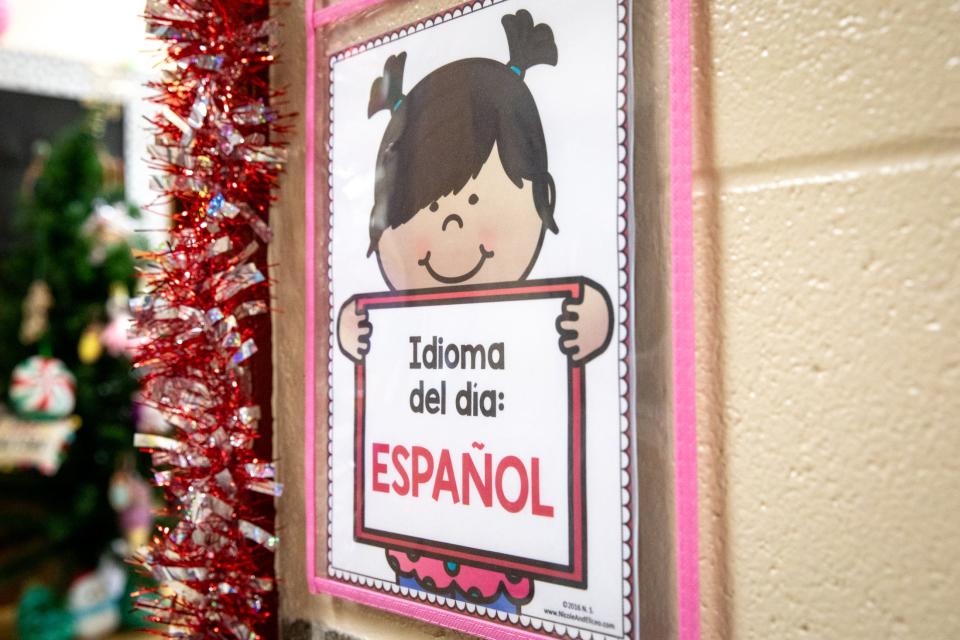
Transitional programs can sometimes be more like a “crutch,” Guzman said, as opposed to a long-term solution.
Districts who launched dual language programs often maintained them for several years, so that children who started elementary school in a dual language program could finish elementary school in a program.
But Guzman said, when funding dries up, dual language programs sometimes disappear. At the same time, districts across the state and nation can also struggle to find bilingual teachers.
Corpus Christi ISD
Corpus Christi ISD first launched a dual language program in the mid-1990s. The program lasted until 2022, when the district shifted focus to pre-K at the Early Childhood Development Center.
Rebecca Palacios was a part of the first generation of bilingual teachers in Corpus Christi in the 1970s. She retired in 2009.
“The biggest difference with my generation is that even though we knew Spanish, we really never got Spanish education,” Palacios said. “We were punished for speaking it. Even though we were Spanish speakers and grew up with it, we never had any formal, Spanish education. It was always English.”
When she first became a bilingual teacher, Palacios was trained in the transitional bilingual education method.
“We taught Spanish to get them quickly speaking English,” Palacios said. “That was the whole point... basically, you’re extinguishing the language — you're taking away as you move forward.”
In the beginning, there weren’t many materials in Spanish for teachers, and what did exist often relied on Spanish from Spain that differed from the vocabulary local children were familiar with, Palacios said.
Bilingual educators began working together to create and share more appropriate materials through groups like the National Association for Bilingual Education, the Texas Association for Bilingual Education and the Corpus Christi Association for Bilingual Education, a group that eventually folded over the years.
When Corpus Christi ISD began implementing dual language, Palacios found it to be “far superior.” Palacios has published books in English and Spanish for dual language families.
In 1995, Corpus Christi ISD and A&M-Corpus Christi partnered on a “school of the future” with a dual language model. Palacios was selected as the lead teacher for the pre-K 3-year program.
After a few years, Palacios started a dual language program at Zavala Elementary School. A federal grant helped start dual language programs at Zavala and Garcia elementary schools.
But the programs didn’t last. Eventually the district switched back to focus on the transitional early-exit model, which is how most elementary-age emergent bilingual students are currently served.
During the 2021-22 school year, the TEA's Emergent Bilingual/English Learner Program Report documents 778 students in transitional programs, about 30 in dual language and over 375 in an alternative bilingual program in Corpus Christi ISD. Over 80 non-bilingual students were also in a dual language program.
At the secondary level, bilingual students are served through ESL programs. The program also includes parental engagement and events. In January, the district hosted an event for students focused on supporting students on the path to college.
In the ESL program, teachers use strategies such as visuals with vocabulary cards, gestures and cognates to help students when there is something they don’t understand. Students who speak a wide variety of languages are part of the program.
At the elementary level, 19 campuses offer bilingual programs. Previously, the district had a transitional program at each district elementary school. But after years with the district unable to find enough bilingual certified teachers, the district shifted to a centralized model this year.
In 2022-23, the district was short nearly 90 bilingual certified teachers. Under the centralized model, more bilingual students are in the classroom with a bilingual teacher.
Students zoned to schools without a transitional program were moved to neighboring campuses with programs. Every campus still offers ESL programs for students speaking other languages, such as Vietnamese, Chinese, Russian and German.
In CCISD transitional programs, students are taught by bilingual certified teachers and provided supports to help them be successful in listening, speaking, writing and reading.
When a student scores high enough on a standardized test measuring English proficiency, they are reclassified and moved into English classrooms.
“We have the bilingual early exit model where students can reclassify at the end of first grade or after having been in the program for two consecutive years,” CCISD director for special programs and curriculum and instruction Zonia Lopez said.
In addition to gaining English proficiency, transitional bilingual programs also aim to allow students to keep their native language, Lopez said.
“The goal, to me, of the bilingual program is to use the student’s native language to acquire the English language and continue to use their native language,” Lopez said.
Cooperation and engagement are currently on the rise among Corpus Christi bilingual educators. Years after the dissolution of the Corpus Christi Association for Bilingual Education, local educators have formed a new group — the Coastal Bend Association for Bilingual Education.
This group includes members from around the region whose schools operate a variety of different bilingual programs, including Corpus Christi ISD and Tuloso-Midway ISD.
Looking forward, Palacios believes that for new successful dual language programs to succeed, schools need community support.
“If you put that energy in there and that supportive piece from the community, it’s going to happen,” Palacios said.
Here's how Driscoll Children's Hospital has provided therapy in Corpus Christi ISD
Academics and post-graduation readiness: Corpus Christi ISD reflects on 2022-23
Kingsville ISD switched to a shortened school week this year. Here's how it's going.
This article originally appeared on Corpus Christi Caller Times: How Coastal Bend schools approach bilingual education

